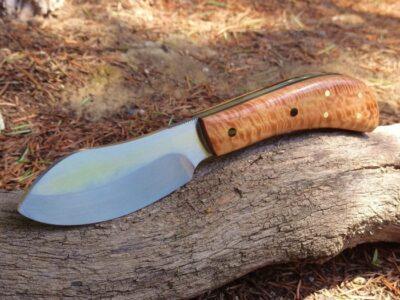
Image source: Blackmountainforge.ca
He was a man of his time, a writer for Forest and Stream magazine around the 1880s, and woodsman among woodsmen. George Washington Sears, affectionately known as Nessmuk, spent many of his days rambling in the backwoods of the Adirondacks in northern New York State.
And while the term “bushcraft” had not yet been coined, he certainly provided a great measure of influence on the art through his writings and practices. But there’s one particular topic from which we can gain a very fundamental lesson, and one that Nessmuk seemed to have authoritatively mastered.
It’s one thing to gain instruction and teaching from modern-day survivalist types that we often see on TV, because they’re certainly not newbies when it comes to getting by in the wilderness. But the reason I tend to lend an ear to men like Nessmuk is because thriving off the land is just what they did and how they lived.
Did Nessmuk have an opinion on ye olde survival knife? Did he even have one?
In a way, I believe that the term “survival knife” itself is evidence of our modern times, because men like Nessmuk weren’t surviving per se. They were in the woods because they wanted to be there in the first place.
A Systemic Approach to Your Blades
At the same time, they’d probably think it an odd thing, simply because he carried a system of blades — not just one. Nessmuk knew that if his gear was whittled down to just one blade, then he was in trouble.
An Amazing Breakthrough In Compact Portable Backup Power — Easily Fits In Your Pocket Or Backpack!
There are three main reasons for this:
- First, a blade is simply a tool. You wouldn’t build a house with just a hammer, so you should probably not expect one knife to perform all the functions necessary for sustaining a wilderness existence.
- Second, multiple blades offer gear/tooling redundancy. Relying on only one primary blade could have you knapping chert in desperation, because it’s just not difficult to lose things out there.
- Third, not all blades are created equal, and some are needed for very specific tasks. To ask one blade to chop off a tree limb and then skin a raccoon shortly thereafter, is going to have you either spending all your time honing the blade … or frustrated that you destroyed a perfectly good raccoon pelt.
But since we now know what kind of blade Nessmuk wouldn’t want to carry (nor expect of it), let’s ask: What blades DID he carry? Just to give you a small hint: It’s a fantastically genius system that seemed to work quite well for the guy. And it also works for self-defense.
1. Ye Olde Ax
As I said, though there are three bladed tools in Nessmuk’s gear selection, as he didn’t carry just three blades. In fact, even his “hatchet” was a smaller-sized double-bit ax.
Why was he fond of the double-bit ax concept?
 It offered him a lightweight, convenient way to carry multiple blades on a single tool. Also, he would then have been able to designate one edge for heavier tasks (like felling a tree) and the other for lighter tasks (like processing firewood). Either way, this offers the ability to have two varying degrees of grinds, sharpness and purposes on the same tool.
It offered him a lightweight, convenient way to carry multiple blades on a single tool. Also, he would then have been able to designate one edge for heavier tasks (like felling a tree) and the other for lighter tasks (like processing firewood). Either way, this offers the ability to have two varying degrees of grinds, sharpness and purposes on the same tool.
2. Pocket knife
Had Nessmuk been able to get his hands on a multi-tool, like a Gerber or Leatherman, he likely would have been thrilled – again, based on our knowledge that he loved multi-purpose items.
At the time, the technology wasn’t available for manufacturing a multi-tool, but he did carry a folding knife. He basically used his folding knife for smaller camp tasks, such as carving and whittling. Especially in those days, you’d rarely ever see these guys packing in their utensils, but instead, you’d see them whittling utensils out of sticks while in the field.
Though, thank goodness that in these days, we can throw a light plastic camping spork in the haversack before trekking into the wild.
3. The pristinely honed “muk” skinner
There was one knife in Nessmuk’s system that was NOT used for multiple purposes: his custom-designed skinner.
For knives that are made for gutting, processing meat and skinning, men like Nessmuk would not want the edge ever touching anything harder than sinew — because those blades would have been honed to perfection and religiously kept that way with daily upkeep.
Also, Nessmuk in particular designed his knife to have a skinner profile: a wide, flat piece of steel with an edge that slightly sloped backward, a spine that sloped forward towards edge at the point, but lacking a sharp tip (which could unintentionally puncture the game, rather than assist in its processing).
Oddly enough, the size of this blade would be considered the closest thing to a “survival knife” these days … but the “muk” himself would have tied you to a canoe and left you in the middle of Lake Placid if you’d have attempted to whack away at a pine tree with it.
His double-bit hatchet, on the other hand, have at it. That’s what it’s there for.
If you could have only three blades, what would they be? Share your suggestion in the section below:
 Off The Grid News Better Ideas For Off The Grid Living
Off The Grid News Better Ideas For Off The Grid Living




